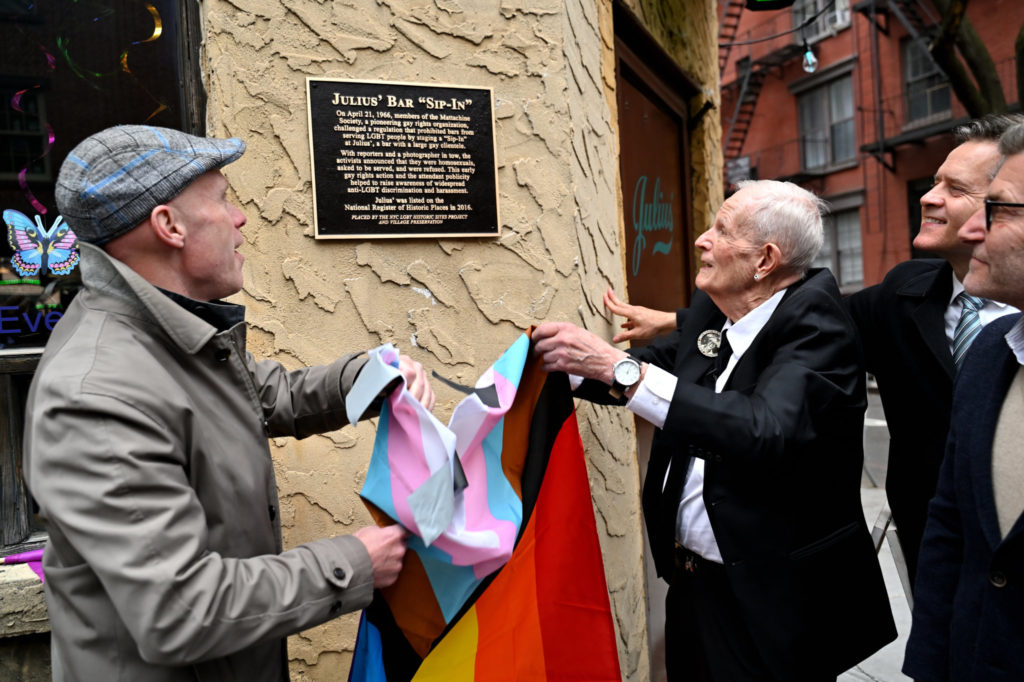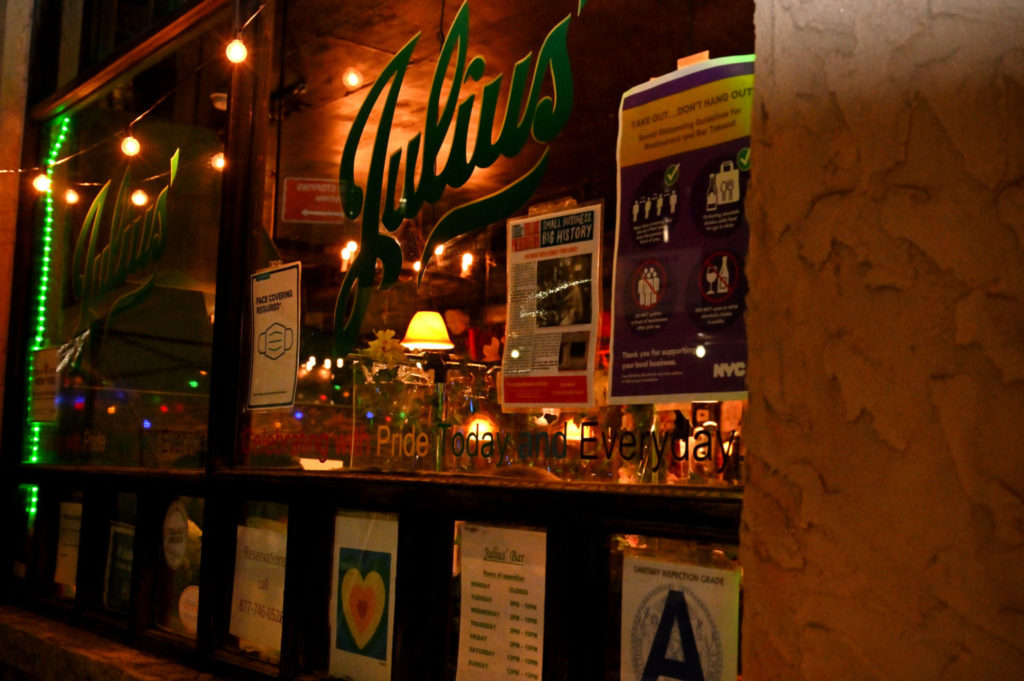Month: December 2022
Julius’ Bar designated as NYC landmark in unanimous vote
December 6, 2022
By: Matt Tracy

DONNA ACETO
The New York City Landmarks Preservation Commission has unanimously designated Julius’ Bar — the oldest gay bar in the city and site of the 1966 “sip-in” demonstration — as an official landmark.
The 11-0 vote, held during a virtual hearing on December 6, was largely symbolic because the bar was already previously protected by a broader landmark designation in the Greenwich Village Historic District, which is made up of a collection of more than 2,000 buildings across 100 blocks in Manhattan. Still, it was hailed as a triumph following a decade-long push to protect the building. Groups such as Village Preservation and the NYC LGBT Historic Sites Project were instrumental in the campaign to designate the bar, which is located at 159 West 10th Street.
During the hearing, the Landmark Preservation Commission’s researchers and commissioners discussed the significance of the location. Michael Caratzas, an architectural historian, retold the story of the 1966 “sip-in” that laid the foundation for the eradication of laws restricting bars from serving alcohol to LGBTQ people.
The pivotal moment in queer history occurred on April 21, 1966 when four gay men with the LGBTQ rights organization known as the Mattachine Society — Dick Leitsch, Randy Wicker, Craig Rodwell, and John Timmons — went from bar to bar stating that they were homosexuals and wanted to be served drinks. Expecting to be rejected, some bars were closed and others were actually willing to serve them drinks. Finally, when the men arrived at Julius’ Bar and asked to be served, a Village Voice photographer took what wound up being an iconic picture of a bartender covering a glass and denying them service. Julius’ Bar may have felt additional pressure to conform to the law because authorities had recently raided the establishment. The bar was not specifically known as a gay bar at the time, but gay patrons frequented the bar.

DONNA ACETO
The demonstration ultimately drew the attention necessary to prompt changes to the state’s liquor law that had banned bartenders from serving queer people.
“As the site of the sip-in, the building shines a light on the activism leading up to the Stonewall Rebellion and remains a place of active LGBTQ history and commemoration,” Caratzas said. “The research staff recommends that the commission vote to designate the Julius’ Bar building as a New York City landmark.”
The Landmarks Preservation Commission’s Bronx representative, Commissioner Michael Goldblum, made it a point to emphasize the barren exterior of the building that houses Julius’ Bar.
“What’s interesting to me about this is that the building is an ugly building in its current form,” Goldblum said. “It does not resemble the historic model that is usually followed by the commission. It holds on to a piece of New York that is disappearing… It’s really about the history and it’s being different, being weird… and I think that’s a beautiful thing.”
Notably, the 1966 “sip-in” occurred at a time when public LGBTQ acceptance was scarce, making the demonstration riskier for the participants.
“[Landmarking] the bar is very important because it marked one of the few sites that really predate even Stonewall in the beginning of the movement,” Wicker told Gay City News in a phone interview on September 13.
Several minutes into the December 6 hearing, the commission swiftly voted to finalize the landmark designation and moved on to the next item on the agenda.
“The Commission’s designation of the Julius’ Bar Building today recognizes and protects the site of the 1966 “Sip-In,” an important early protest against the persecution of LGBTQ+ people that drew vital attention to unjust laws and practices and paved the way for future milestones in the fight for LGBTQ+ rights,” Landmarks Preservation Commission Chair Sarah Carroll said in a written statement after the vote.
In an email celebrating the designation, Village Preservation noted that it was 10 years ago to the week when the organization first filed a request with the state to make Julius’ Bar a candidate for the state and national registers of Historic Places. The following year, Village Preservation recommended that the city designate Julius’ Bar, the Stonewall Inn, the LGBT Community Center, and the former site of the Gay Activist Alliance as New York City landmarks. All of those sites have been landmarked.
The designation drew applause from out gay Councilmember Erik Bottcher, who represents the District 3 neighborhoods of Chelsea, Hell’s Kitchen, Greenwich Village, West SoHo, Hudson Square, Times Square, Garment District, Flatiron, and Upper West Side.
“As a gay man who enjoys countless freedoms that were unimaginable in their time, I owe enormous debt to the activists who made Julius’ Bar the site of their protest,” out gay Councilmember Erik Bottcher, who represents the neighborhood, said in a written statement. “Landmarks should tell the history of all New Yorkers, including those from marginalized communities.”
The Landmarks Preservation Commission praised the work of the LGBT Historic Sites Project, which has documented numerous locations across the five boroughs that have carved out a place in LGBTQ history.
“The NYC LGBT Historic Sites Project is thrilled that the Landmarks Preservation Commission has designated the Julius’ Bar Building as an official landmark,” Andrew Dolkart, co-director of the NYC LGBT Historic Sites Project, said in a written statement. “One of the first initiatives that the Sites Project undertook after its founding was the completion of the nomination that succeeded in getting Julius’ listed on the National Register of Historic Places for its significance as the site of the so-called “sip-in,” at which three courageous gay men sought to challenge the New York State rule that a bar could not serve a known homosexual.”
In a joint statement issued on November 10, two out state lawmakers — Assemblymember Deborah Glick and State Senator Brad Hoylman — threw their support behind the campaign to landmark the bar.
“[The ‘sip-in’] was an important early step that would pave the way for the LGBT community to raise awareness of the systemic injustices they endured and would eventually culminate with the Stonewall Uprising in June of 1969,” Glick and Hoylman said. “It has long been a critical ‘must-see’ destination for LGBT visitors from across the country and even the world.”